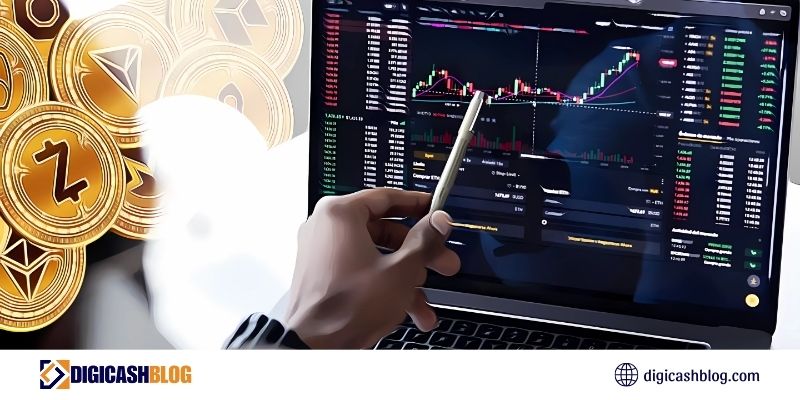The world of cryptocurrency is constantly evolving, and one of the most critical aspects to monitor is crypto trading trends in volatile markets. Market volatility presents both opportunities and risks, making it essential for traders to stay updated on emerging trends, strategies, and technologies. As digital assets experience rapid price fluctuations, understanding the latest developments in crypto trading can help investors maximize profits and minimize losses.
This article explores the key crypto trading trends in volatile markets, analyzing the strategies traders employ, the impact of regulatory changes, the role of institutional investors, and the emergence of advanced trading tools. By understanding these trends, traders can navigate the complex and unpredictable nature of crypto markets with confidence.

The Impact of Market Volatility on Crypto Trading
Understanding Crypto Market Volatility
Cryptocurrency markets are known for their extreme volatility, with prices fluctuating by double-digit percentages within hours. This volatility is driven by factors such as regulatory news, macroeconomic events, market sentiment, and technological developments.
Bitcoin and Ethereum, the two largest cryptocurrencies by market capitalization, have experienced numerous bull and bear cycles, with rapid price increases followed by severe corrections. For example, in 2021, Bitcoin surged to an all-time high of over $60,000 before plunging below $30,000 within months. This highlights the unpredictable nature of the market and the importance of risk management.
How Traders Respond to Market Volatility
To adapt to volatile conditions, traders adopt various strategies such as swing trading, scalping, and arbitrage. Many also rely on risk management techniques like stop-loss orders and portfolio diversification to minimize potential losses while capitalizing on price swings.
Swing trading involves holding assets for days or weeks to capitalize on short-term price movements. Scalping, on the other hand, is a high-frequency strategy where traders make multiple small trades within a day to profit from minor price changes. Arbitrage trading exploits price discrepancies across exchanges to make risk-free profits.
Key Crypto Trading Trends in Volatile Markets
Algorithmic Trading and AI-Driven Strategies
One of the most significant crypto trading trends in volatile markets is the rise of algorithmic trading. AI-powered bots execute trades at high speeds based on predefined parameters, allowing traders to take advantage of market inefficiencies. These tools enhance decision-making and remove emotional biases from trading.
Many hedge funds and institutional investors utilize AI-based algorithms to predict price movements based on historical data and real-time market sentiment analysis. This automation reduces human error and improves execution speed, giving traders an edge in volatile markets.
The Growth of Derivatives Trading
Crypto derivatives, including futures and options, have gained immense popularity in volatile markets. These instruments allow traders to hedge their risks and speculate on price movements without directly holding the underlying assets. The increasing adoption of perpetual contracts and leveraged trading platforms has further fueled this trend.
For instance, Binance and Bybit offer leverage of up to 100x, allowing traders to amplify potential gains. However, high leverage also increases risk, and liquidation is a common occurrence for traders who do not manage their positions properly.
The Rise of Copy Trading
Copy trading has become an emerging trend where retail investors replicate the trades of successful traders. This approach allows beginners to benefit from the experience of professional traders without extensive market knowledge.
Platforms like eToro and Binance Copy Trading provide users with the ability to follow top traders and execute their strategies automatically. This trend is expected to grow as more retail investors seek passive investment strategies in volatile markets.

Institutional Involvement and Market Stability
Institutional Investors Shaping Crypto Trading
The entrance of institutional investors into the crypto space has contributed to market maturity. Hedge funds, asset managers, and publicly traded companies are increasingly incorporating cryptocurrencies into their portfolios, leading to higher liquidity and reduced volatility.
MicroStrategy, Tesla, and Square are among the prominent companies that have invested in Bitcoin as part of their corporate treasury strategy. Institutional adoption provides greater market stability and fosters confidence among retail investors.
Regulatory Developments and Their Impact
Regulatory changes significantly influence crypto trading trends in volatile markets. Governments and financial institutions worldwide are implementing clearer regulations, which provide legitimacy to the industry while affecting market dynamics. Traders need to stay informed about new regulations to adjust their strategies accordingly.
For example, the SEC’s increasing scrutiny over cryptocurrency exchanges and DeFi platforms impacts market sentiment and liquidity. The introduction of central bank digital currencies (CBDCs) also presents new opportunities and challenges for traders.
The Role of DeFi in Volatile Market Conditions
Decentralized Exchanges and Liquidity Pools
Decentralized Finance (DeFi) is reshaping how crypto trading operates. DeFi platforms offer decentralized exchanges (DEXs) and liquidity pools, providing traders with alternative ways to access markets without relying on centralized intermediaries. These innovations enhance liquidity and trading efficiency, even in highly volatile conditions.
Uniswap, SushiSwap, and PancakeSwap have become go-to platforms for decentralized trading, allowing users to swap tokens without intermediaries. The use of automated market makers (AMMs) has improved liquidity and made DeFi trading more accessible.
Yield Farming and Staking as Alternatives
Yield farming and staking have become popular among traders looking to generate passive income during volatile periods. These mechanisms provide a way to earn rewards while waiting for market conditions to stabilize, making them an essential part of risk management strategies.

Risk Management Strategies for Crypto Traders
Stop-Loss and Take-Profit Orders
Setting stop-loss and take-profit orders is a fundamental strategy for managing risk. By defining exit points in advance, traders can limit potential losses and secure profits before market conditions shift unexpectedly.
Portfolio Diversification and Stablecoin Hedging
Diversifying a crypto portfolio across multiple assets and utilizing stablecoins as hedging tools are effective ways to mitigate risk. Stablecoins provide a safe haven during market downturns, offering stability amidst high volatility.

Emerging Technologies and Future Trading Trends
The Role of Blockchain Analytics in Trading
Blockchain analytics tools are becoming increasingly important in identifying market trends and potential risks. On-chain data analysis helps traders make informed decisions based on real-time transaction activity, whale movements, and liquidity flows.
The Future of Decentralized Trading Platforms
The next phase of crypto trading will likely involve more sophisticated decentralized trading platforms that integrate AI, smart contract automation, and advanced risk management features. These innovations will further enhance market efficiency and trader profitability.
In the fast-paced world of cryptocurrency, staying informed about crypto trading trends in volatile markets is crucial for success. From algorithmic trading and derivatives to DeFi innovations and institutional involvement, various factors shape the trading landscape. By leveraging emerging technologies, implementing effective risk management strategies, and adapting to market fluctuations, traders can navigate volatility with confidence.
To stay ahead of the latest crypto trading trends in volatile markets, follow Digicash Blog—your go-to source for expert insights and cutting-edge analysis in the crypto space.

